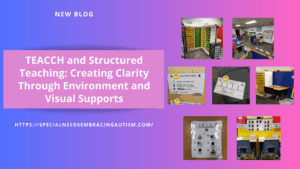
Introduction
Challenging behavior is often one of the most visible barriers to success for individuals with autism—especially in inclusive classroom settings. These behaviors are rarely random; rather, they often emerge from a lack of understanding, unexpected transitions, or environments that are too chaotic or overstimulating. The TEACCH (Treatment and Education of Autistic and Communication-Handicapped Children) model offers a proactive, structured approach that reduces anxiety and fosters a sense of control and safety for students. By clearly defining routines, expectations, and environments, TEACCH Structured Teaching not only minimizes disruptive behaviors but also helps students thrive behaviorally and emotionally.

Predictable Environments Reduce Anxiety
One of the foundational components of the TEACCH approach is creating a highly predictable physical and visual environment. Students with autism often experience heightened anxiety when they are unsure of what will happen next or if routines suddenly change. When classrooms are organized with consistent schedules, clearly labeled work areas, and visually supported instructions, students feel more secure and in control—leading to significant decreases in behavior outbursts.
Tip: Use a visual daily schedule that students can refer to throughout the day. Velcro-backed visuals allow changes when needed, without creating confusion.


Clear Expectations Guide Behavior
When expectations are communicated verbally alone, many students with autism may miss critical information due to processing delays or language difficulties. Visual reminders such as rule posters (e.g., “Hands to self,” “Use quiet voice,” or “Wait your turn”) serve as constant, accessible cues. These visuals should be displayed at eye level and reviewed routinely to ensure they are meaningful and understood.
Classroom Practice: Begin each day by reviewing the classroom rules using visuals and role-play to reinforce positive behaviors.

Choice Boards Empower Without Overwhelming
Offering choices is a well-known strategy for promoting cooperation, but for students with autism, too many options or open-ended questions can be overwhelming. TEACCH encourages the use of structured choice boards with limited, visually presented options. This provides autonomy while maintaining structure.
Example: During a work break, a student may choose between reading a book or using a fidget toy—both options support self-regulation.

Calm Spaces Support Self-Regulation
TEACCH environments often include clearly designated calm-down areas or “quiet zones.” These spaces are not used as punishment but rather as proactive supports for students who feel overwhelmed. These areas include soothing visuals, sensory items, and a visual timer to guide the duration of the break.
Behavioral Benefit: Students learn to recognize their emotional state and use the calm space independently, rather than engaging in meltdowns or escape behaviors.

Visual Strategies for Transitions
Transitions are a common trigger for challenging behavior. Tools like “First-Then” boards provide a visual cue of what is happening now and what is coming next. This reduces resistance and increases engagement in non-preferred tasks.
Real-Life Example: A student resistant to writing might respond more positively when shown a First-Then visual—“First write name, then Legos.”

Picture Ideas
- A cozy, clearly labeled “Calm Corner” with bean bags, noise-canceling headphones, and visuals.
- A close-up of a laminated First-Then board being used in a classroom.
- A visual rule chart posted near a group area with illustrated expectations.

Conclusion
TEACCH’s Structured Teaching approach transforms the learning environment into one of clarity, consistency, and compassion. By minimizing confusion and emphasizing predictability, educators can prevent many behaviors before they start—allowing students with autism to feel safe, understood, and ready to learn.
Let’s continue to build supportive spaces where behavior is understood, not punished. Together, we can reduce anxiety and embrace autism—one visual support at a time!

Together, let’s raise awareness, build understanding, and embrace autism as we shape a more inclusive world!
References
- TEACCH Behavior Management Strategies: https://teacch.com/about-us/approach/
- Visual Supports and Autism – Autism Focused Intervention Resources & Modules (AFIRM): https://autismpdc.fpg.unc.edu/visual-supports



No Comments